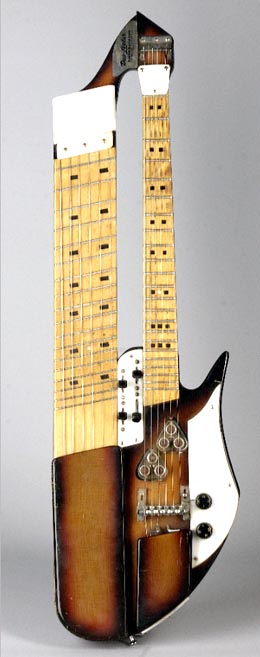On September 16, 1957, a patent application drawn up by Seattle attorney Lynn Robinson is filed with the U.S. Patent Office in an effort to establish legal protection for an invention by Northwest musician David D. Bunker (1935-2021). Bunker's uniquely designed twin-necked Duo-Lectar guitar will ultimately become the very first such instrument to be granted a patent.
Bunker Guitar Technology
The origins of that patent -- and of today's Bunker Guitar Technology company of Marysville, in Snohomish County -- trace back to the 1950s when Dave Bunker, the son and grandson of timber-workers who also happened to be amateur instrument-makers, made his first guitar while living in Puyallup. That guitar was no ordinary guitar, but rather a genuine do-it-yourself project constructed of miscellaneous odds and ends, including a less-than-adequate store-bought electro-magnetic pickup device, and metal frets sliced from an old chainsaw blade.
But that's only half the story. That first guitar also boasted two necks -- the lower one for the left hand to play bass lines on, while the right hand simultaneously played lead lines on the top neck. And furthermore, that right hand played its notes by "touching" or "tapping" the strings from above rather than gripping them from behind the neck, as a left hand traditionally does. (The path to popularizing touch or tap style guitar playing would prove to be a long one for Bunker and a handful of other pioneering enthusiasts, but in subsequent decades the technique was brought to full flower by such wunderkind stars as Eddie Van Halen [b. 1955], Stanley Jordan [b. 1959], Steve Vai [b. 1960], and Jeff Healey [1966-2008]).
Patent Patience
It didn't take long for Bunker to realize that his prototype instrument needed some design upgrades, in particular an all-new pickup design and a simple muting system that would both help isolate the signal produced by each individual string and avoid cross-over bleeding of all the ringing strings. After much experimentation Bunker succeeded in inventing both and they would be among the key claims in his patent application.
Bunker drew initial sketches of the components and physical attributes of this latest guitar and made a trip to Seattle, where he met attorney Lynn Robinson (of the Robinson & Berry law firm, a precursor to Seattle's Seed Intellectual Property Law Group) -- who happened also to be a semi-pro bassist who fully understood what Bunker was up to. After those sketches were redone (by Benjamin Berry, Esq.) up to industry standards, a patent application for the Duo-Lectar guitar was submitted to the U.S. Patent Office on September 16, 1957, and the long wait for a response began.
In the meantime, Bunker and Robinson actually began playing some local gigs together. More time passed. Bunker and his wife Reita -- who already had a son, David L. Bunker (b. 1956) -- had a couple daughters, Teresa (b. 1958), and Brenda (b. 1959). And Bunker hung in there with a job at the Boeing aircraft plant, where he befriended several engineers who helped him solve some additional guitar-design problems. And more time passed.
Patent Granted
Bunker's patent application was finally granted on June 27, 1961. That patent (No. 2,989,884) covered both the overall design of the twin-necked "touch guitar" and its manual muting device.
Bunker's patented mute was a seemingly simple invention. It was essentially a strip of cloth placed across the neck's first fret, which successfully kept the open strings -- those not being touched at any particular time during a song's performance -- silent. Many years later it could be noted that "[t]he manual mute that Dave invented, or a reworked version of it, is seen on many tapping guitars and other tapping instruments in use today" (Jean German).
Bunker himself later outlined the key design innovations represented by his guitar, calling it "the first string-type instrument in the world which could be played using two necks (or fretboards) at the same time, one with three octaves of bass and one with four octaves of standard guitar. Because of the Bunker patented muting method which made this possible, it opened up a complete new method of play" (Press Release).

